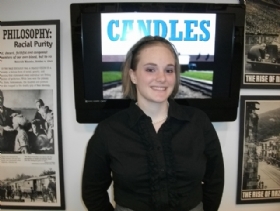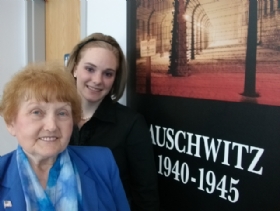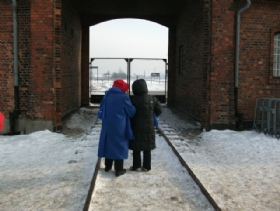Laura A. Pearce '10
April 10, 2010
Last fall, Laura A. Pearce ’10 was invited by Eva Kor, a Holocaust survivor, to join her on a trip to Poland to observe the 65th anniversary of the Liberation of  Auschwitz that took place on Jan. 27. Kor is the founding director of CANDLES Holocaust Museum in Terre Haute. CANDLES is an acronym for Children of Auschwitz Nazi Deadly Lab Experiments Survivors.
Auschwitz that took place on Jan. 27. Kor is the founding director of CANDLES Holocaust Museum in Terre Haute. CANDLES is an acronym for Children of Auschwitz Nazi Deadly Lab Experiments Survivors.
Pearce, a history major and intern at the museum, has worked with Kor for three semesters and has developed a close relationship with her. Pearce began her internship when she took the course, Internship in Public History, with her adviser, Professor John T. Schlotterbeck. The class centers on discussions of public history – museums and monuments. Part of the course requirement is an internship at a historical museum or site. Pearce chose CANDLES.
While the course requirement was only a one-semester internship, Pearce asked museum coordinator Kiel Majewski if she could stay. He hired her – two days a week – for a small stipend.
“Last fall, the museum staff was planning a trip to Auschwitz for the 65th anniversary of the Liberation. One day, I was working with Eva, and she said, ‘You know, you should come with us when we go to Auschwitz.’ The invitation was all I needed,” Pearce says. “I made it work and got to go on the trip.”
Kor (at right with Pearce) was a Mengele twin. She and her sister survived the horrible experiments of Dr. Josef Mengele, the Angel of Death. Most twins died as a result of the experiments. “Every two and a half years, Eva goes back to Auschwitz and takes a group of people – teachers, preferably, because teaching the Holocaust in schools is important to her.
“There were 55 of us on the trip from all backgrounds – teachers, college students, middle school students, and people who had personal connections to the Holocaust,” Pearce says. “It was an incredible experience – a once in a lifetime opportunity.
“There are two things that really stand out that I’ll never forget. The day after we arrived in Poland, we went to Auschwitz II- Birkenau, which is the camp where the majority of the Jews were taken and where the mass exterminations took place,” Pearce says. “We stood on the selection platform, and Eva told us the story of when she and her family exited the cattle cars and were on that selection platform.
“I’ve probably heard her tell that story 25 or 30 times – because when she’s giving presentations, that’s part of her story. However, standing there on the selection platform at Auschwitz was the first time I have ever heard her waver or catch a word in her throat. I don’t think she cried, but you could hear the tears in her voice as she told her story. “The other memory that I’ll never forget was on our second day. We went to Auschwitz I, which is now a museum. Auschwitz II - Birkenau is very desolate and very empty. Auschwitz I is a lot more purposeful, I suppose. The barracks have been turned into exhibit spaces.
“The other memory that I’ll never forget was on our second day. We went to Auschwitz I, which is now a museum. Auschwitz II - Birkenau is very desolate and very empty. Auschwitz I is a lot more purposeful, I suppose. The barracks have been turned into exhibit spaces.
“We went into one room, and in the doorway I caught my breath. In the very next room, on the left hand side was a glass panel. Back at least 10 feet behind the glass was just hair. It’s full – not piles, but a sea of hair,” Pearce says. “Walking in and seeing that, it hit me. It’s one thing to read about all of these things, but it’s completely another thing to see remnants of the people who died there.
“I’ve read extensively about the Holocaust. I’m a history major. I know the history. I work at the museum and know personal experiences from Eva. But to go there, to stand on the selection platform, to see the pile of hair and shoes – it makes it real.
When Pearce returned to campus, she found it more necessary to tell people about it. The experience gave her the ability to share the Holocaust with other people and to get other people interested in learning more and becoming informed.
“I feel honored to be able to work at the museum and to get to know Eva – to hear her stories and learn from her experiences. It’s so important to learn from people who went through these atrocities. Pretty soon the survivors won’t be around any more, and we’re the ones who are going to have to tell their stories.”
From the beginning, Pearce was given a lot of responsibility as an intern at the museum. “Kiel asked me to look through the museum and take notes about what I liked and didn’t like. He wanted me to share what I thought the museum could improve – from a fresh perspective,” Pearce says.
“From my suggestions, we started setting up projects for me for me to work on. I began taking the exhibit spaces and making them more purposeful – making the story lines more coherent. I’ve been making each case have its own narrative and labeling all of the objects.
“Kiel doesn’t consider himself my boss anymore. We work together and bounce ideas off each other. It’s been really wonderful. I want to go into public history at some point, so this has been an invaluable experience.
“I’m sad that I’ll have to leave the museum and all the projects I’ve worked on. I’m definitely taking these experiences with me – what I’ve learned from Eva and Kiel and what the museum, as a whole, has really taught me: the importance of remembering the Holocaust and the importance of respecting others.
“I’ll definitely carry those lessons with me and teach them as much as I can, and I’ll share my experiences with others with the hopes of making a difference.
In June, Pearce is moving to the Mississippi Delta to begin a two-year commitment to Teach For America.